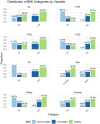Development of a comprehensive risk prediction model for arterial stiffness assessment in individuals with obesity
- PMID: 39224613
- PMCID: PMC11368134
- DOI: 10.3389/fmed.2024.1430437
Development of a comprehensive risk prediction model for arterial stiffness assessment in individuals with obesity
Abstract
Introduction: Obesity in adults is a known risk factor for cardiovascular events and is associated with a decline in arterial elasticity. This study aims to evaluate the utility of pulse wave analysis (PWA) parameters in routine clinical practice for the primary prevention of cardiovascular events by developing a prediction model for arterial stiffness among obese and overweight individuals.
Methods: The study enrolled 84 adult patients, aged 18 to 85 years, with varying degrees of weight status, including optimal weight, overweight, and obesity. The lifestyle habits, the personal and family history of cardiometabolic diseases, as well the clinical evaluation that included BMI (body mass index), WHR (waist-to-hip ratio), WC (waist circumferance) were performed. PWA evaluation was conducted using the Mobil-O-Graph device, assessing the following parameters: pulse wave velocity (PWV), augmentation index (AIx), heart rate (HR), central pulse pressure (cPP), peripheral and central blood pressure (SBP, DBP, cSBP, cDBP). Body composition analysis was performed using the TANITA BC-418 body analyzer. Laboratory results from the past 3 months were also collected during initial nutritional consultations for each patient.
Results: Family history of cardiovascular events showed positive correlations with all PWA parameters, while diabetes history only with PWV and family history of obesity with PWV, DBP, and cSBP. Insufficient sleep duration showed positive associations with all arterial stiffness parameters except cDBP. Smoking status correlated with significantly elevated PWV and Aix values, while insufficient physical activity was associated solely with PWV. Positive correlations were showed between current weight and PWV, while WC demonstrated positive associations with PWV, SBP, and cSBP. Body composition analysis revealed significant associations between trunk adipose tissue mass (%) and PWV, SBP, and cSBP. Hydration status (%) emerged as an independent predictor for PWV, exhibiting an inverse relationship. HOMA-IR (Homeostatic Model Assessment for Insulin Resistance) showed a strong positive correlation with PWV. Negative associations were observed with HDL-c and vitamin D. Threshold values for age, cDBP and Cardiac Index providing positive diagnostic for vascular impairment.
Conclusion: The assessment of arterial stiffness can be considered a reliable approach to prevent obesity-related cardiovascular events and facilitate the comprehensive management of such pathologies.
Keywords: arterial stiffness; bioimpedance; obesity; overweight; pulse wave velocity.
Copyright © 2024 Pescari, Borlea, Mihuta and Stoian.
Conflict of interest statement
The authors declare that the research was conducted in the absence of any commercial or financial relationships that could be construed as a potential conflict of interest.
Figures




Similar articles
-
Unveiling the Silent Danger of Childhood Obesity: Non-Invasive Biomarkers Such as Carotid Intima-Media Thickness, Arterial Stiffness Surrogate Markers, and Blood Pressure Are Useful in Detecting Early Vascular Alterations in Obese Children.Biomedicines. 2023 Jun 26;11(7):1841. doi: 10.3390/biomedicines11071841. Biomedicines. 2023. PMID: 37509481 Free PMC article.
-
The Oscillometric Pulse Wave Analysis Is Useful in Evaluating the Arterial Stiffness of Obese Children with Relevant Cardiometabolic Risks.J Clin Med. 2022 Aug 29;11(17):5078. doi: 10.3390/jcm11175078. J Clin Med. 2022. PMID: 36079009 Free PMC article.
-
Evaluating the Arterial Stiffness as a Useful Tool in the Management of Obese Children.Children (Basel). 2023 Jan 18;10(2):183. doi: 10.3390/children10020183. Children (Basel). 2023. PMID: 36832311 Free PMC article.
-
Relationship between fundus of the eye examination and arterial stiffness.Front Cardiovasc Med. 2025 Jan 6;11:1516787. doi: 10.3389/fcvm.2024.1516787. eCollection 2024. Front Cardiovasc Med. 2025. PMID: 39834731 Free PMC article. Review.
-
Arterial Stiffness and Incident Diabetes.Pulse (Basel). 2023 Dec 21;12(1):12-18. doi: 10.1159/000535775. eCollection 2024 Jan-Dec. Pulse (Basel). 2023. PMID: 38229880 Free PMC article. Review.
References
-
- World Health Organization . Obesity and Overweight. Geneva: World Health Organization; (2021). Available at: http://www.who.int/en/news-room/fact-sheets/detail/obesity-and-overweight (accessed January 4, 2024).
-
- Centers for Disease Control and Prevention . Adult Obesity Prevalence Maps. Atlanta (GA): Centers for Disease Control and Prevention (2023). Available at: http://www.cdc.gov/obesity/data/prevalence-maps.html (accessed January 4, 2024).
-
- Zsálig D, Berta A, Tóth V, Szabó Z, Simon K, Figler M, et al. . A review of the relationship between gut microbiome and obesity. Appl Sci. (2023) 13:610. 10.3390/app13010610 - DOI
LinkOut - more resources
Full Text Sources
Miscellaneous

